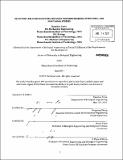| dc.contributor.advisor | Shuguang Zhang and Bruce Tidor. | en_US |
| dc.contributor.author | Corin, Karolina A. (Karolina Ann), 1981- | en_US |
| dc.contributor.other | Massachusetts Institute of Technology. Dept. of Biological Engineering. | en_US |
| dc.date.accessioned | 2011-11-18T21:00:15Z | |
| dc.date.available | 2011-11-18T21:00:15Z | |
| dc.date.copyright | 2011 | en_US |
| dc.date.issued | 2011 | en_US |
| dc.identifier.uri | http://hdl.handle.net/1721.1/67203 | |
| dc.description | Thesis (Ph. D.)--Massachusetts Institute of Technology, Dept. of Biological Engineering, 2011. | en_US |
| dc.description | Cataloged from PDF version of thesis. | en_US |
| dc.description | Includes bibliographical references. | en_US |
| dc.description.abstract | Mammalian noses can detect and distinguish an inestimable number of odors at minute concentrations. Four classes of G protein-coupled receptors (GPCRs) are responsible for this remarkable sensitivity: olfactory receptors (ORs), vomeronasal receptors (VNRs), trace amine-associate receptors, and formyl peptide receptors. Structural knowledge of these receptors is necessary to understand the molecular basis of smell. However, no structure exists for three main reasons. First, milligrams of protein are needed for crystallization screens, but most are expressed at low levels endogenously or in heterologous expression systems. Second, detergents capable of solubilizing and stabilizing these proteins in aqueous solution must be found. Third, the flexible nature of GPCRs can inhibit crystal lattice formation. Methods for overcoming each obstacle were developed. Milligrams of a VNR were expressed in HEK293 cells, and milligrams of 13 GPCRs were expressed in a cell-free system. All could be purified to >90%. The purified receptors had correct secondary structures, and could bind their ligands. The HEK293 and cell-free receptors had nearly identical structures and binding affinities, demonstrating that cell-free expression can be used for GPCR production and mutational studies. To demonstrate this, six variants of mOR103-15 with single amino acid substitutions were expressed. Ligand-binding measurements indicated which residues were involved in ligand recognition. The choice of detergent used in the cell-free system was critical, and significantly affected expression levels. A class of amphiphilic peptide detergents was designed and tested with the receptors. These detergents could be used to express milligrams of functional receptors. The peptide tail and head group properties did not significantly affect their function, suggesting that they may be a class of surfactants usable with multiple olfactory-related receptors, and even other membrane proteins. Lastly, the protein T4 Lysozyme (T4L) was fused in the 3rd intracellular loop of two receptors to increase potential crystal lattice contact points. Purified T4L variants had correct secondary structures, and could bind their ligands and initiate intracellular signaling. The methods described generated sufficient quantities of pure receptors for crystal screens. The large number of functionally expressed GPCRs indicates that these techniques can be applied to other olfactory-related receptors, and even other membrane proteins. | en_US |
| dc.description.statementofresponsibility | by Karolina Corin. | en_US |
| dc.format.extent | 174 p. | en_US |
| dc.language.iso | eng | en_US |
| dc.publisher | Massachusetts Institute of Technology | en_US |
| dc.rights | MIT theses are protected by copyright. They may be viewed, downloaded, or printed from this source but further reproduction or distribution in any format is prohibited without written permission. | en_US |
| dc.rights.uri | http://dspace.mit.edu/handle/1721.1/7582 | en_US |
| dc.subject | Biological Engineering. | en_US |
| dc.title | Olfactory-related receptors : methods towards enabling structural and functional studies | en_US |
| dc.type | Thesis | en_US |
| dc.description.degree | Ph.D. | en_US |
| dc.contributor.department | Massachusetts Institute of Technology. Department of Biological Engineering | |
| dc.identifier.oclc | 758868995 | en_US |
